Why Data Visualization Is Important?

Ayavin Solutions
November 2, 2022Why Data Visualization Is Important?
By transforming data into a more understandable format and highlighting trends and outliers, data visualization aids in the telling of stories. By removing noise from data and emphasizing important information, a good visualization tells a story. The importance of data visualization is simple: it enables people to see, interact with, and better understand data. Regardless of their level of expertise, the right visualization, whether simple or complex, can bring everyone on the same page.
It's difficult to think of a professional industry that wouldn't benefit from improved data comprehension. Every STEM field, as well as government, finance, marketing, history, consumer goods, service industries, education, sports, and so on, benefits from data understanding.
While we will continue to varnish profound about data visualization, there are undeniable practical, real-world applications. Because visualization is so common, it is also one of the most valuable professional skills to develop. The more effectively you can leverage that information, the better you can visually convey your points, whether in a dashboard or a slide deck. The concept of citizen data scientists is gaining traction. To meet the demands of a data-driven world, skill sets are evolving. Professionals who can use data to make decisions and use visuals to tell stories about how data informs the who, what, when, where, and how are in high demand.
While traditional education typically distinguishes between creative storytelling and technical analysis, the modern professional world values those who can bridge the gap: data visualization falls squarely between analysis and visual storytelling.
Accessible ways to view and understand data are more important than ever in our increasingly data-driven world. After all, the demand for data skills among employees continues to rise year after year. Data must be understood by employees and business owners at all levels. Data visualization comes into play here. Many businesses use data visualization in the form of dashboards to analyze and share information, with the goal of making data more accessible and understandable.
Advantages of data visualization-
????Something as simple as graphically presenting data may appear to have no disadvantages. When data is displayed in the incorrect data visualization style, it can be misrepresented or misinterpreted. Consider both the advantages and disadvantages of creating a data visualization.
Colors and patterns pique our interest. We can easily tell the difference between red and blue, as well as squares and circles. From art and advertisements to television and movies, everything in our culture is visual. Data visualization is another type of visual art that grabs and holds our attention. We can quickly identify trends and outliers when we look at a chart. When we see something, we internalize it quickly. It's a story with a point. If you've ever looked through a large spreadsheet of data and couldn't find a trend, you know how much more effective visualization can be.
- Another benefit of data visualization is how easily information can be shared.
- Investigate options interactively.
- Make patterns and connections visible.
Disadvantages of data visualization-
While there are numerous benefits, some disadvantages may be less obvious. When viewing a visualization with many different data points, for example, it's easy to make an incorrect assumption. Sometimes the visualization is simply designed incorrectly, resulting in bias or confusion.
- Other drawbacks include biased or inaccurate information.
- Correlation is not always synonymous with causation.
- Translation can cause key messages to be lost.
